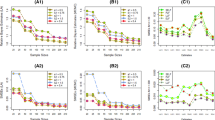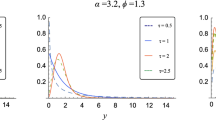Abstract
In this paper, a new flexible approach to modeling data with multiple partial right-censoring points is proposed. This method is based on finite mixture models, flexible tool to model heterogeneity in data. A general framework to accommodate partial censoring is considered. In this setting, it is assumed that a certain portion of data points are censored and the rest are not. This situation occurs in many insurance loss data sets. A novel probability function is proposed to be used as a mixture component and the expectation-maximization algorithm is employed for estimating model parameters. The Bayesian information criterion is used for model selection. Additionally, an approach for the variability assessment of parameter estimates as well as the computation of quantiles commonly known as risk measures is considered. The proposed model is evaluated using a simulation study based on four common probability distribution functions used to model right skewed loss data and applied to a real data set with good results.







Similar content being viewed by others
References
Bakar SA A, Hamzaha N A, Maghsoudia M, Nadarajah S (2015) Modeling loss data using composite models. Insur Math Econ 61:146–154
Balakrishnan N, Mitra D (2011) Likelihood inference for lognormal data with left truncation and right censoring with an illustration. J Stat Plan Inference 141:3536–3553
Balakrishnan N, Mitra D (2012) Left truncated and right censored Weibull data and likelihood inference with an illustration. Comput Stat Data Anal 56:4011–4025
Balakrishnan N, Mitra D (2013) Likelihood inference based on left truncated and right censored data from a gamma distribution. IEEE Trans Reliab 62:679–688
Bang S, Cho H, Jhun M (2016) Simultaneous estimation for non-crossing multiple quantile regression with right censored data. Statistics and Computing 26:131–147
Beirlant J, Goegebeur Y, Teugels J, Segers J (2004) Statistics of Extremes, 1st edn. Wiley, Hobuken, NJ
Biernacki C, Celeux G, Govaert G (2003) Choosing starting values for the EM algorithm for getting the highest likelihood in multivariate Gaussian mixture models. Comput Stat Data Anal 413:561–575
Blostein M, Miljkovic T (2019a) ltmix: Left-Truncated Mixtures of Gamma. Weibull, and Lognormal Distributions, r package version (2)
Blostein M, Miljkovic T (2019) On modeling left-truncated loss data using mixtures of distributions. Insur Math Econ 85:35–46
Bordes L, Chauveau D (2016) Stochastic EM algorithms for parametric and semiparametric mixture models for right-censored lifetime data. Comput Stat 31:1513–1538
Calderín-Ojeda E, Kwok CF (2016) Modeling claims data with composite stoppa models. Scandinavian Actuarial Journal 9:817–836
Chauveau D (1995) ‘A stochastic EM algorithm for mixture with censored data. J Stat Plan 46:1–25
Coorey K, Ananda MM (2005) Modeling actuarial data with a composite Lognormal-Pareto model. Scandinavian Actuarial Journal 5:321–334
Frees E, Valdez E (1998) Understanding relationships using copulas. N Am Actuar J 2:1–15
Gruen B, Leisch F, Sarkar D, Mortier F (2019) ltmix: Left-Truncated Mixtures of Gamma, Weibull, and Lognormal Distributions, r package version 2.3-15
Gui W, Huang R, Lin XS (2018) Fitting the Erlang mixture model to data via a GEM-CMM algorithm. J Comput Appl Math 343:189–205
Hoeting JA, Madigan D, Raftery AE, Volinsky CT (1999) Bayesian model averaging: a tutorial. Stat Sci 14:382–401
Hubert L, Arabie P (1985) Comparing partitions. J Classif 2:193–218
Klugman S A, Panjer H H, Willmot G E (2012) Loss Models: From Data to Decisions, 4th edn. Wiley, Hobuken, NJ
Klugman S A, Parsa R (1999) Fitting bivariate loss distribution with copulas. Insur Math Econ 24:139–148
Lee G, Scott C (2012) EM algorithms for multivariate Gaussian mixture models with truncated and censored data. Comput Stat Data Anal 56:2816–2829
Lee SCK, Lin XS (2010) Modeling and evaluating insurance losses via mixtures of Erlang distributions. N Am Actuar J 14:107–130
McLachlan G, Jones SAA (1988) Fitting mixture models to grouped and truncated data via the EM algorithm. Biometrics 22:571–578
McLachlan G, Peel D (2000) Finite mixture models. Wiley, Hobuken, NJ
McNeil A (1997) Estimating the tails of loss severity distributions using extreme value theory. ASTIN Bull 27:117–137
Melnykov V, Michael S, Melnykov I (2015) Recent developments in model-based clustering with applications. In: Celebi ME (ed) Partitional clustering algorithms. Springer, Berlin, pp 1–39
Michael S, Melnykov V (2016) An effective strategy for initializing the EM algorithm in finite mixture models. Adv Data Anal Classif 10:563–583
Miljkovic T, Grün B (2016) Modeling loss data using mixtures of distributions. Insur Math Econ 70:387–396
Pigeon M, Denuit M (2011) Composite Lognormal–Pareto Model with random threshold. Scandinavian Actuarial Journal 3:177–192
R Core Team (2016) R: A Language and Environment for Statistical Computing. R Foundation for Statistical Computing, Vienna, Austria
Resnick SI (1997) Discussion of the Danish data on large fire insurance losses. ASTIN Bull 27:139–151
Ross S M (2014) Introduction to probability models, 11th edn. Academic Press, New York
Schwarz G (1978) Estimating the dimension of a model. Ann Stat 6:461–464
Scollnik DP (2007) On composite Lognormal-Pareto models. Scan Actuar J 1:20–33
Sun Z, Ye X, Sun L (2018) Consistent test for parametric models with right-censored data using projections. Comput Stat Data Anal 118:112–125
Verbelen R, Gong L, Antonio K, Badescu A, Lin S (2015) Fitting mixtures of Erlangs to censored and truncated data using the EM algorithm. ASTIN Bull 45:729–758
Author information
Authors and Affiliations
Corresponding author
Additional information
Publisher's Note
Springer Nature remains neutral with regard to jurisdictional claims in published maps and institutional affiliations.
Electronic supplementary material
Below is the link to the electronic supplementary material.
Rights and permissions
About this article
Cite this article
Michael, S., Miljkovic, T. & Melnykov, V. Mixture modeling of data with multiple partial right-censoring levels. Adv Data Anal Classif 14, 355–378 (2020). https://doi.org/10.1007/s11634-020-00391-x
Received:
Revised:
Accepted:
Published:
Issue Date:
DOI: https://doi.org/10.1007/s11634-020-00391-x




